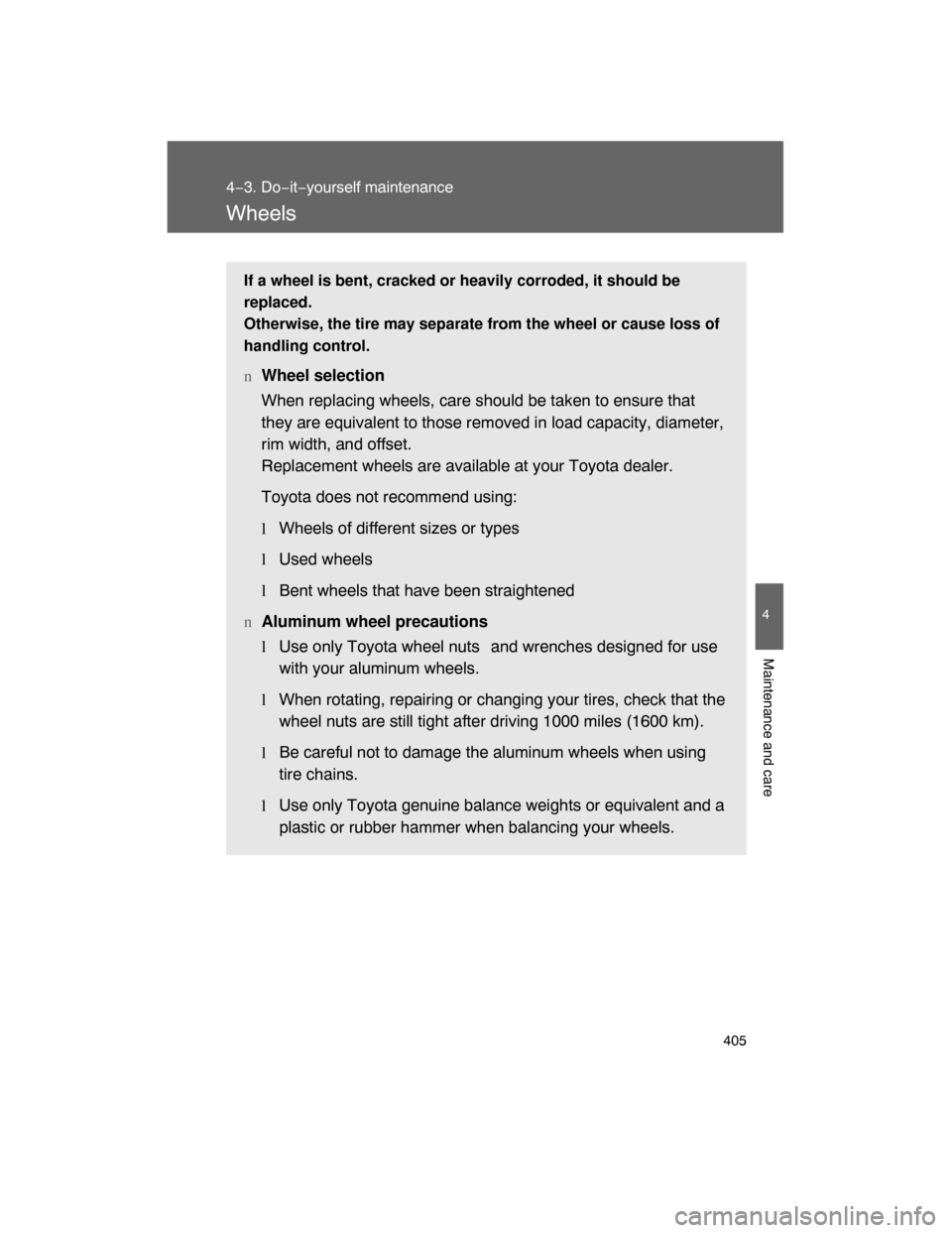Page 235 of 531

237
2−5. Driving information
2
When driving
CAUTION
nTrailer towing precautions
lFollow all the instructions described in this section. Failure to do so could
cause an accident resulting in death or serious injury.
lExceeding the towing capacity, GVWR, GCWR and GAWR can cause an
accident resulting in death or serious personal injuries.
nTo avoid accident or injury
lDo not exceed 45 mph (72 km/h) or the posted towing speed limit, which−
ever is lower. As instability (swaying) of the towing vehicle−trailer combina−
tion increases as speed increases, exceeding 45 mph (72 km/h) may
cause loss of control.
lSlow down and downshift before descending steep or long downhill
grades. Do not make sudden downshifts.
lAvoid holding the brake pedal down too long or applying the brakes too
frequently. This could cause the brakes to overheat and result in reduced
braking efficiency.
lDo not exceed the trailer hitch assembly weight, gross vehicle weight,
gross axle weight and trailer tongue load capacities.
lNever load more weight in the back than in the front of the trailer. About
60% of the load should be in the front half of the trailer, and the remaining
40% in the rear.
l
Do not use cruise control when you are towing.
Page 391 of 531

396 4−3. Do−it−yourself maintenance
nMaximum load of tire
Check that the maximum load of the re
placed tire is greater than 1/2 of
the Gross Axle Weight Ratings (GAWR) of either the front axle or the
rear axle, whichever is greater.
As for the maximum load of the tire, see the load limit at maximum cold
tire inflation pressure mentioned on the sidewall of the tire, and as for the
Gross Axle Weight Ratings (GAWR)
, see the Certification Label. ( P.
401, 507).
nTire types
1 Summer tires
Summer tires are high−speed performance tires best suited to highway
driving under dry conditions. Sinc
e summer tires do not have the same
traction performance as snow tire s, summer tires are inadequate for
driving on snow−covered or icy roads. For driving on snow−covered
roads or icy roads, the use of
snow tires is recommended. When
installing snow tires, be sure to replace all four tires.
2 All season tires
All season tires are designed to prov ide better traction in snow and to
be adequate for driving in most winter conditions, as well as for use
year round. All season tires, however, do not have adequate traction
performance compared with snow tires in heavy or loose snow. Also,
all season tires fall short in acceleration and handling performance
compared with summer tires in highway driving.
3Snow tires
For driving on snow−covered roads or icy roads, we recommend using
snow tires. If you need snow tires,
select tires of the same size, con−
struction and load capacity as the or iginally installed tires. Since your
vehicle has radial tires as original equipment, make sure your snow
tires also have radial construction. Do not install studded tires without
first checking local regulations for possible restriction. Snow tires
should be installed on all wheels. (
P. 222)
Page 396 of 531
401
4−3. Do−it−yourself maintenance
4
Maintenance and care
Tire inflation pressure
nTire inflation pressure
The recommended cold tire inflation pressure and tire size is dis−
played on the tire and loading information label. (
P. 502)
TIRE SIZECOLD TIRE PRESSUREPXXX/XXRXX
PXXX/XXRXXXXXkPa,XXPSI
XXXkPa,XXPSI
XXXkPa,XXPSI
PXXX/XXRXXPXXX/XXRXX
PXXX/XXRXX
PXXX/XXRXXXXXkPa,XXPSI
FRONT
REAR
SPAREPNEUSDIMENSIONPRESSION
GONFLAGE A FROIDDEXXXkPa,XXPSI
XXXkPa,XXPSI AVA N TARRIERESECOURS
TIRE
SEE MANUAL
ADDITIONAL INFORMATIONFOR OWNER’S
AND LOADINGSEATINGTheand cargo should never exceed XXX XXXkg lbs.orcombined weight occupantsofCAPACITY TOTAL
FRONT
POUR
VOIR
LE DUMANUEL PROPRIETAIREDEPLUS AMPLES INFORMATIONS,
REARINFORMATIONINFORMATION
NOMBRE
Le
doit jamais etre a kg lb.ouXXX XXXsuperieur poids totaldes et du nechargementoccupantsDE PLACES ASSISESTOTAL X
AVA N T XARRIEREXSUR LES ET LEPNEUSCHARGEMENTXXX
ITY43C072
Page 400 of 531

405
4−3. Do−it−yourself maintenance
4
Maintenance and care
Wheels
If a wheel is bent, cracked or heavily corroded, it should be
replaced.
Otherwise, the tire may separate from the wheel or cause loss of
handling control.
nWheel selection
When replacing wheels, care should be taken to ensure that
they are equivalent to those removed in load capacity, diameter,
rim width, and offset.
Replacement wheels are available at your Toyota dealer.
Toyota does not recommend using:
lWheels of different sizes or types
lUsed wheels
l
Bent wheels that have been straightened
n
Aluminum wheel precautions
l
Use only Toyota wheel nuts and wrenches designed for use
with your aluminum wheels.
l
When rotating, repairing or changing your tires, check that the
wheel nuts are still tight after driving 1000 miles (1600 km).
lBe careful not to damage the aluminum wheels when using
tire chains.
lUse only Toyota genuine balance weights or equivalent and a
plastic or rubber hammer when balancing your wheels.
Page 490 of 531
497
6−1. Specifications
6
Vehicle specifications
Lubrication system
Oil viscosity:
l
The 0W portion of the oil viscosity rating indicates the characteristic
of the oil which allows cold startab ility. Oils with a lower value before
the W allow for easier starting of the engine in cold weather.
lThe 20 in 0W−20 indicates the oil viscosity when the oil is as its oper−
ating temperature. An oil with a higher viscosity may be better suited
if the vehicle is operated at high
speeds, or under extreme load con−
dition.
Oil capacity drain and
refill
(Reference)
with filter
without filter7.4 qt. (7.0 L, 6.2 lmp.qt.)
7.0 qt. (6.6 L, 5.8 lmp.qt.)
Oil grade
ILSAC multigrade engine oil
Recommended oil
viscosity
Use Toyota approved “Toyota Genuine Motor Oil”
or equivalent to satisfy the above grade and vis−
cosity.
Outside temperature
Page 505 of 531

512 6−1. Specifications
Warning: The temperature grades for this tire are established for a
tire that is properly inflated and not overloaded.
Excessive speed, underinflation, or
excessive loading, either sepa−
rately or in combination, can cause heat buildup and possible tire fail−
ure.
Glossary of tire terminology
Tire related term Meaning
Cold tire inflation
pressureTire pressure when the vehicle has been
parked for three hours or more, or has not
been driven more than 1 mile or 1.5 km under
that condition
Maximum inflation
pressureThe maximum cold inflated pressure to which a
tire may be inflated, shown on the sidewall of
the tire
Recommended
inflation pressureCold tire inflation pressure recommended by a
manufacturer.
Accessory weightThe combined weight (in excess of those stan−
dard items which may be replaced) of trans−
mission, power steering, power brakes, power
windows, power seats, radio and heater, to the
extent that these items are available as factory−
installed equipment (whether installed or not)
Curb weightThe weight of a motor vehicle with standard
equipment, including the maximum capacity of
fuel, oil and coolant, and if so equipped, air
conditioning and additional weight optional
engine
Maximum loaded
vehicle weight
The sum of:
(a) Curb weight
(b) Accessory weight
(c) Vehicle capacity weight
(d) Production options weight
Page 506 of 531

513
6−1. Specifications
6
Vehicle specifications
Tire related term Meaning
Normal occupant
weight150 lb. (68 kg) times the number of occupants
specified in the second column of Table 1
* that
follows
Occupant distributionDistribution of occupants in a vehicle as speci−
fied in the third column of Table 1
* below
Production options
weightThe combined weight of installed regular pro−
duction options weighing over 5 lb. (2.3 kg) in
excess of the standard items which they
replace, not previously considered in curb
weight or accessory weight, including heavy
duty brakes, ride levelers, roof rack, heavy duty
battery, and special trim
RimA metal support for a tire or a tire and tube
assembly upon which the tire beads are seated
Rim diameter
(Wheel diameter)Nominal diameter of the bead seat
Rim size designation Rim diameter and width
Rim type designationThe industry manufacturer ’s designation for a
rim by style or code
Rim width Nominal distance between rim flanges
Vehicle capacity
weight (Total load
capacity)The rated cargo and luggage load plus 150 lb.
(68 kg) times the vehicle’s designated seating
capacity
Vehicle maximum load
on the tire
The load on an individual tire that is determined
by distributing to each axle its share of the
maximum loaded vehicle weight, and dividing
by two
Page 511 of 531
518 6−1. Specifications
Designated seating
capacity, Number of
occupants
Vehicle normal load,
Number of occupantsOccupant distribution in
a normally loaded
vehicle
2 through 4 2 2 in front
5 through 10 32 in front, 1 in second
seat
11 through 15 52 in front, 1 in second
seat, 1 in third seat, 1
in fourth seat
16 through 20 72 in front, 2 in second
seat, 2 in third seat, 1
in fourth seat